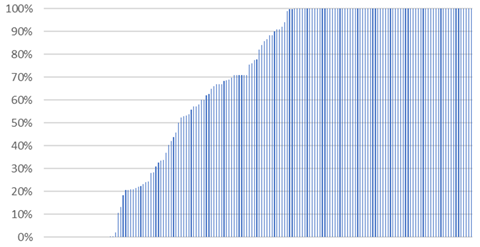| ORGANISATION DETAILS | |
|---|---|
| Name | Amundi |
| Signatory type | Asset manager |
| Region of operation | Global |
| Assets under management | €1,653bn (as at 31/12/2019) |
| COVERED IN THIS CASE STUDY | |
|---|---|
| Name of fund | an Amundi green bonds strategy |
| Asset class | Fixed income |
| Geography | Global |
| Environmental objective | Mitigation |
| Economic activity | All |
Amundi supports the development of the EU taxonomy for Sustainable Finance, which allows investors, companies, issuers and project promoters to navigate the transition to a low-carbon, resilient and resource-efficient economy. We believe it is crucial that all stakeholders have the same frameworks, language and level of understanding of the technical aspects of the low-carbon transition.
We advocate that flexibility be built into the final form of the taxonomy so that new “green” technologies can be included, and that a social dimension, with an emphasis on equity and integrity, is central. Amundi has conducted discussions with our ESG data providers on how to adapt their criteria to encompass the recommendations of the EU Technical Expert Group’s (TEG) sustainable classification framework.
Taxonomy implementation
Principles, criteria, thresholds
Green bonds (GBs) generally finance activities that contribute to at least one of the six key EU environmental objectives. However, the taxonomy currently covers only two of them: climate change mitigation and adaptation. Projects in support of biodiversity for instance have yet to be covered.
As adaptation activities are still a tiny fraction of the projects financed by GBs globally (around 2% according to CBI data), we decided to focus our analysis on activities deemed to have positive impacts from a climate change mitigation perspective (i.e. clean energy, green buildings, sustainable transportation, manufacture of low carbon technologies, forestry, and some water and waste projects). We mapped the relevant activities from the technical annex of the final TEG taxonomy report and drew out the relevant principles and technical thresholds. For each GB invested in the fund (and for the flow of new GBs), we examined the corresponding minimum eligibility criteria, by project category, as defined by issuers in their GB framework/documentation (second party opinions, investor presentations). This dataset was complemented by information from available GBs allocation and impact reports.
We considered projects, or project categories, as not aligned when they failed to meet the thresholds set by the EU taxonomy, or where a lack of information made reaching a conclusion difficult.
Do no significant harm assessment
The do no significant harm (DNSH) criteria for climate change mitigation activities can either be quantitative or process-based and qualitative. We mapped the DNSH criteria for each of the key activity types financed by GBs. It was immediately clear that some quantitative criteria set by the taxonomy were more specific than information usually made available in GB documentation. For example, to check the risk of “excessive water consumption due to inefficient water appliances” for green buildings, the quantitative threshold is: “All relevant water appliances […] must be in the top 2 classes for water consumption of the EU Water Label.”
Given this shortfall, we tested DNSH and social safeguards alignment in a similar way to the existing GBs due diligence process, verifying both GB documentation for standards and policies implemented by the issuer when conducting projects - with reference to the UN Global Compact (UNGC), International Finance Corporation (IFC) standards or sector specific norms such as the Hydropower Sustainability Protocol – and ESG controversies, leveraging an external data provider. Although not as precise as some DNSH quantitative criteria set by the taxonomy, we believe this adheres to the overarching principle and fosters investor confidence in the issuer’s business conduct.
Social safeguards assessment
As above.
Social safeguards refer to corporate and financing activities complying with OECD Guidelines on Multinational Enterprises (MNEs) and UN Guiding Principles on Business and Human Rights, with specific reference to ILO core labor conventions.
Turnover/capex/opex alignment
As the fund that we screened exclusively invests in GBs, we assessed the level of alignment at a use-of-proceeds level. We gathered detailed data on the allocation of proceeds of each bond in the portfolio.
Allocation reporting is usually made available to investors a year after the pricing of the bond, and around 45% of the GBs in the fund were less than one year old. To avoid conducting the taxonomy alignment assessment on only slightly more than half of the fund, we made assumptions, using an order of priority for recent green bonds as follows: any specific available guidance on the expected breakdown of proceeds by project type; proxies such as available breakdowns of the pool of eligible projects; the assumption that the proceeds would be equally allocated to each eligible project type in the GB framework.
Alignment results
Based on our review of 170 GBs, we identified alignment of over 67% at the fund level BEFORE the strict application of DNSH and minimum social safeguards tests.
For 14% of the bonds in the portfolio, we found no alignment with the taxonomy. However, while in a few cases, the type of activity financed was not present in the taxonomy (e.g. copper-to-fibre telecommunication network projects), in most cases, the activity appeared in the taxonomy but criteria were either not met or were different from those used by the taxonomy. This was particularly the case for GBs financing green buildings. We also noted that while some projects were deemed as not aligned from a climate change mitigation perspective, they may eventually show a strong alignment as the taxonomy expands to activities with benefits for the other four EU environmental objectives.
It was generally difficult to find enough relevant information to accurately carry out DNSH and social safeguards tests against all the quantitative and qualitative criteria set by the taxonomy. However, by approximation and assuming that significant breaches with EU and international sustainability standards would normally lead to negative press repercussions, our controversy analysis provided some assurance that the projects financed are a priori aligned with the overall DNSH principle.
Distribution of the estimated level of alignment on a bond-by-bond basis BEFORE the application of DNSH and minimum social safeguards tests.
Taxonomy alignment by green bond (%)

Source: Amundi
Challenges and solutions
| NO. | CHALLENGE | SOLUTION |
|---|---|---|
| 1 | Correspondence issues |
Technical criteria in the taxonomy do not always match the eligibility criteria commonly used by GBs issuers. This is particularly the case for green buildings, a significant project category in terms of GB proceed allocation (around 25% according to CBI data). GBs issuers largely use international or country-specific sustainable building certification schemes, such as Leadership in Energy and Environmental Design (LEED) or Building Research Establishment Environmental Assessment Method (BREEAM), which often rate the building’s energy-efficiency alongside other sustainability criteria. We built correspondence tables between taxonomy criteria and the main building certification schemes. For BREEAM, we found that a certification level of ‘Excellent’ matches the EU criteria of 20% better energy efficiency than the building code - with the taxonomy using Nearly Zero Energy Buildings (NZEB) reference values for building codes. Matching LEED certification levels with the taxonomy thresholds was less straightforward. However, based on the data, we found that a LEED Gold level could be adopted as a proxy for a minimum certification level (LEED Gold buildings are on average c.33% more energy efficient than the local norm). This is a proxy rather than a strict guarantee as some LEED Gold buildings have similar energy-efficiency to the reference building code. Detailed information on the various certification levels achieved by buildings financed by the bond was not always available. We found similar correspondence issues in other eligible activities such as low-carbon vehicles: Toyota’s GBs reference US norms for fuel/CO2 efficiency, while the EU taxonomy uses the Worldwide Harmonised Light Vehicle Test Procedure (WLTP). |
| 2 | Lack of allocation data for recent GBs and lack of detailed allocation data by project type/technology |
We faced issues of availability and granularity of proceed allocation breakdown by project. Proceed allocation data was generally made available to investors about one year after the bond issuance, and our targeted GBs fund was significantly exposed to recent (<1 year-old) bonds. To avoid reaching a zero alignment for GBs where final allocation data was not available, we made assumptions to estimate future allocation by project type. We also used assumptions when we lacked sufficient detail in the proceed allocation breakdown provided by issuers. For example, a GB was 100% allocated to eligible renewable energy projects (solar, wind and biomass) but lacked granular allocation by technology. The eligibility criteria used by the issuer for biomass projects precluded projects such as these being aligned with the technical threshold of the taxonomy (RED II benchmark threshold). Therefore, we assumed that a third of the proceeds were not aligned. |
| 3 | Lack of available data to perform comprehensive and strict due diligence for all DNSH criteria and minimum safeguards |
Some DNSH criteria are extremely detailed and specific, and available GB documentation data did not allow us to check all these criteria. We used approximation to verify if the issuer conducted its business responsibly and properly managed E&S risks attached to project development. Although not implemented for this case study, engagement and discussion with GBs issuers can be a tool to ensure that some specific DNSH criteria are met. |
Recommendations
Though there is no doubt that data providers will propose turnkey solutions, we expect to see significant discrepancies in terms of output as they use different interpretation and approximation approaches.
While detailed in-house analysis and application of the EU taxonomy is very time-consuming, we believe there is value in understanding all the pitfalls. This should help to assess the robustness of the approaches taken by different data providers, even if applied on a limited sample of issuers or GBs.












